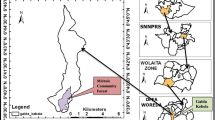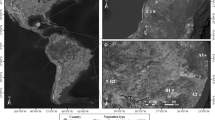Abstract—
The tarbagan, or Mongolian marmot (Marmota sibirica Radde 1862), is one of the typical members of steppe ecosystems in southwestern Transbaikalia. The study of regularities reflecting the effect of ecological factors on tarbagan abundance will allow us to develop a model of the ecological niche of this species and to carry out efficient environmental measures for its preservation. The effect of ecological factors (topographic, edaphic, vegetation, anthropogenic disturbance, and cohabitation with the Daurian pika and long-tailed ground squirrel) on tarbagan abundance was studied in the Kyakhtinsk, Dzhidinsk, and Selenginsk administrative districts of Buryatia (southwestern Transbaikalia). In May–August 2015–2018, using the method of linear transects (1000 m long) with the establishment of four test plots (50 × 50 m in size), a total of 95 transects with 380 plots was set in each of them. The differences in the abundance of plots were significant depending on the height of their surface above sea level (Pearson criterion χ2 = 23.422, p < 0.001, df = 2) and stony conditions (χ2 = 15.219, p < 0.001, df = 1). The association of the abundance with other habitat parameters (edaphic, heterogeneity or homogeneity of vegetation, and disturbance) was not significant. The presence of inhabited burrows and colonies of the Daurian pika in most places inhabited by the tarbagan (χ2 = 21.772, p < 0.001, df=1) indicates similar requirements of these species to certain habitat parameters (for example, stony conditions of locations). No inhabited burrows and settlements of long-tailed ground squirrel were found on the plots inhabited by tarbagan (χ2 = 0.443, p = 0.506, df = 1); most likely, seed-eating ground squirrels and marmots have different feed preferences.


Similar content being viewed by others
REFERENCES
Ad’’yaa, Ya., Mongol tarvaga: biologi, ekologi, khamgaalal, azh akhuyn kholbogdol, Ulaanbaatar: Admon, 2000.
Allaine, D., Rodrigue, I., Le Berre, M., and Ramousse, R., Habitat preferences of alpine marmots, Marmota marmota, Can. J. Zool., 1994, vol. 72, pp. 2193–2198.
Bannikov, A.G., Mlekopitayushchie Mongol’skoi Narodnoi Respubliki (Mammals of the Mongolian People’s Republic), Moscow: Akad. Nauk SSSR, 1954.
Batzli, G.O., Harper, S.J., Lin, Y.-T.K., and Desy, E.A., Experimental analyses of population dynamics: scaling up to the landscape, in Landscape Ecology of Small Mammals, New York: Springer, 1999, pp. 107–127.
Belovezhets, K.I., The theory of the temperature regime of hibernation of marmots, in Proshloe, nastoyashchee i budushchee surkov Evrazii: Sb. nauch. tr. (Past, Present, and Future of Marmots of Eurasiac), Moscow: ABF Media, 2015, pp. 42–51.
Berendyaev, S.A. and Kul’kova, N.A., On intraspecific relations of gray marmots, Zool. Zh., 1965, vol. 44, no. 4, pp. 110–116.
Bibikov, D.I., Gornye surki Srednei Azii i Kazakhstana (Mountain Marmots of Central Asia and Kazakhstan), Moscow: Nauka, 1967.
Demin, N.N., Shortanova, T.Kh., and Emirbekov, E.Z., Neirokhimiya zimnei spyachki mlekopitayushchikh (Neurochemistry of Mammalian Hibernation), Leningrad: Nauka, 1988.
Dmitriev, P.P., Mammals in the steppe ecosystems of Inner Asia, in Trudy sovmestnoi rossiisko-mongol’skoi kompleksnoi biologicheskoi ekspeditsii (Proceedings of Joint Russian–Mongolian Complex Biological Expedition), Moscow, 2006, vol. 48.
Dugarov, V.I. and Kulikov, A.I., Agrofizicheskie svoistva merzlotnykh pochv (Agrophysical Properties of Permafrost Soils), Novosibirsk: Nauka, 1990.
Eregdendagva, D., Tarbagan of the Mongolian People’s Republic and its economic use, Extended Abstract of Cand. Sci. (Biol.) Dissertation, Irkutsk, 1959.
Hanski, I., Uskol’zayushchii mir: ekologicheskie posledstviya utraty mestoobitanii (An Elusive World: The Environmental Impacts of Habitat Loss), 2nd ed., Moscow: Tovarishchestvo nauchnykh izdanii KMK, 2015.
Kalabukhov, N.I., Spyachka mlekopitayushchikh (Hibernation of Mammals), Moscow: Nauka, 1985.
Keyser, Ch., Hibernation, in Physiological Mammalogy, New York: Academic, 1965, vol. 2, pp. 179–211.
Kulikov, A.I., Dugarov, V.I., and Korsunov, V.M., Merzlotnye pochvy: ekologiya, teploenergetika i prognoz produktivnosti (Frozen Soils: Ecology, Heat Power Engineering, and Productivity Forecast), Ulan-Ude, 1997.
Nekipelov, V.N., An essay of the biology of the tarbagan, Izv. Irkutsk. Nauchno-Issled. Protivochumn. Inst. Sibiri Dal’nego Vostoka, 1950, vol. 8, pp. 27–44.
Nekipelov, V.N., Tarbagan. Southeastern Transbaikalia, in Surki. Rasprostranenie i ekologiya (Marmots. Distribution and Ecology), Moscow: Nauka, 1978, pp. 164–177.
Ognev, S.I., Zveri SSSR i prilezhashchikh stran (Animals of the USSR and Neighboring Countries), vol. 5: Gryzuny (Rodents), Moscow: Akad. Nauk SSSR, 1947.
Puzachenko, Yu.G., Matematicheskie metody v ekologicheskikh i geograficheskikh issledovaniyakh (Mathematical Methods in Environmental and Geographic Research), Moscow: ACADEMIA, 2004.
Reshchikov, M.A., Stepi Zapadnogo Zabaikal’ya (Steppes of Western Transbaikalia), Moscow: Akad. Nauk SSSR, 1961.
Ricankova, V.P., Riegert, J., Semancikova, E., Hais, M., Cejkova, A., and Prach, K., Habitat preferences in grey marmots (Marmota baibacina), Acta Theriol., 2014, vol. 59, pp. 317– 324.
Rozhnov, V.V., Poyarkov, A.D., Brandler, O.V., Gromov, V.S., and Badmaev, B.B., State of Mongolian marmot (tarbagan) (Marmota sibirica Radde, 1862) on the territory of Russia at the beginning of 21st century, Byull. Mosk. O-va Ispyt. Prir., Otd. Biol., 2005, vol. 110, no. 4, pp. 21–32.
Shvetsov, Yu.G., Tarbagan. Southwestern Transbaikalia, in Surki. Rasprostranenie i ekologiya (Marmots. Distribution and Ecology), Moscow: Nauka, 1978, pp. 154–164.
Snitsarenko, N.I., Thermal regime, in Klimat Ulan-Ude (Climate of Ulan-Ude), Leningrad: Gidrometeoizdat, 1983, pp. 59–82.
Suntsov, V.V., Ecology of the tarbagan in Tuva, Extended Abstract of Cand. Sci. (Biol.) Dissertation, Moscow, 1982.
Zhukov, V.M., Klimat Buryatskoi ASSR (Climate of the Buryat ASSR), Ulan-Ude: Buryatskoe knizhnoe izd-vo, 1960.
ACKNOWLEDGMENTS
The author is grateful to N.G. Borisova for assistance in planning the parameters of the test plot. The author is especially grateful to the anonymous reviewer, whose comments improved the manuscript of this article.
Funding
This work was supported by a State Assignment, project no. AAAA-A17-117011810035-6.
Author information
Authors and Affiliations
Corresponding author
Ethics declarations
Conflict of Interest
The author declares that there is no conflict of interest.
Statement of the Welfare of Animals
All applicable international, national, and/or institutional guidelines for the care and use of animals were followed.
Additional information
Translated by A. Barkhash
Rights and permissions
About this article
Cite this article
Badmaev, B.B. Effect of Ecological Factors on the Abundance of the Tarbagan (Marmota sibirica, Rodentia, Sciuridae) in Southwestern Transbaikalia. Biol Bull Russ Acad Sci 48, 1123–1130 (2021). https://doi.org/10.1134/S1062359021070050
Received:
Revised:
Accepted:
Published:
Issue Date:
DOI: https://doi.org/10.1134/S1062359021070050




